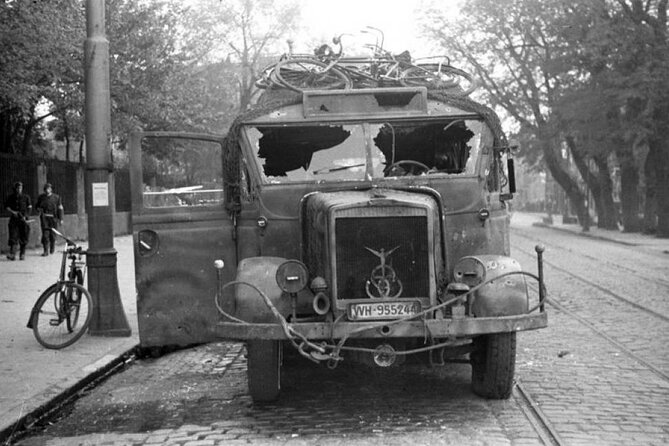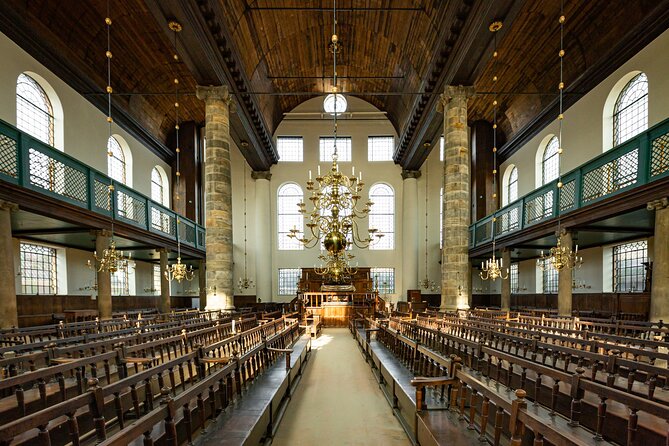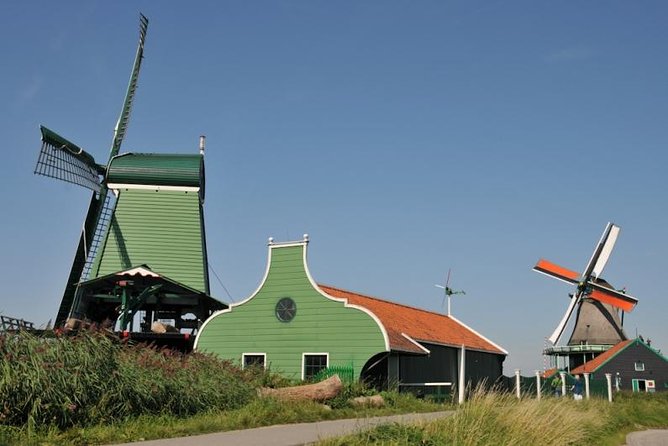Explore the haunting remnants of a city scarred by war on the Amsterdam in World War Two Cycle Tour. As the sun casts long shadows over the cobbled streets, cyclists pedal past historic landmarks that whisper tales of resilience and tragedy.
Amidst the gentle hum of wheels on pavement, a journey unfolds that unveils Amsterdam’s hidden wartime secrets, inviting contemplation and connection to a past that lingers in the city’s very foundations. A riveting blend of history and heartache awaits those who choose to trace the poignant path of Amsterdam’s World War Two narrative.
Just The Basics

- Guided tour reveals Amsterdam’s WWII history
- Uncover resistance stories and heroism
- Experience war memorials and their significance
- Learn from Anne Frank’s legacy of resilience
It's also worth checking out some other tours and experiences nearby.
Tour Overview
When embarking on the Amsterdam World War Two Cycle Tour, visitors are guided through a historical journey of significant wartime sites in Amsterdam. Local guides provide insights into the historic sites, offering a detailed narrative of the events that unfolded during World War Two.
These knowledgeable guides enrich the experience by sharing lesser-known stories and facts about the city’s involvement in the war. They bring to life the impact of the war on Amsterdam and its inhabitants, creating a poignant and educational tour for participants.
Historic Locations
Exploring Amsterdam’s historic locations on the World War Two Cycle Tour unveils a tapestry of wartime narratives woven into the city’s streets. Cyclists will encounter significant historic sites such as the Anne Frank House, where the famous diarist and her family hid during the war.
This tour also leads riders to the Dutch Resistance Museum, showcasing wartime artifacts and stories of heroism. As participants pedal through the city, they pass by the Hollandsche Schouwburg, a former Jewish theater turned deportation center during the occupation.
The tour provides a unique perspective on Amsterdam’s past, offering a glimpse into the struggles and resilience of its inhabitants during World War Two.
War Memorials
Amsterdam’s World War Two Cycle Tour uncovers poignant war memorials scattered throughout the city, each telling a somber tale of sacrifice and remembrance. These memorials hold significant historical importance, serving as reminders of the city’s past during wartime.
Here are three notable war memorials that participants of the tour may encounter:
- The National Monument: Located on Dam Square, this monument commemorates Dutch victims of World War II and subsequent conflicts.
- Homomonument: Recognized as the world’s first memorial honoring persecuted homosexuals, this triangle-shaped monument symbolizes solidarity and remembrance.
- De Dokwerker: This statue in the Jonas Daniel Meijerplein square honors the February Strike of 1941, where Dutch workers protested against the deportation of Jews.
Resistance Stories
Unveiling tales of resilience and defiance, the Amsterdam World War Two Cycle Tour reveals captivating stories of resistance during one of the darkest periods in history. Underground heroes and forgotten sacrifices come to life as visitors pedal through the city streets, learning about courageous acts and wartime bravery that shaped Amsterdam’s wartime narrative. These stories of ordinary citizens turned heroes highlight the strength and determination of those who fought against oppression and injustice. The tour sheds light on the unsung heroes who risked everything to resist the Nazi occupation, inspiring visitors with their bravery and sacrifices.
| Resistance Stories | Description |
|---|---|
| Underground Heroes | Ordinary citizens turned heroes who risked everything to resist the Nazi occupation. |
| Forgotten Sacrifices | Stories of bravery and sacrifices that are often overlooked in history. |
| Courageous Acts | Accounts of daring and courageous actions taken to defy the oppressors. |
Anne Frank’s Legacy
Anne Frank’s Legacy endures as a poignant reminder of the resilience and hope that emerged from adversity during World War Two. Her impact transcends time, offering valuable lessons from her wartime struggles:
- Symbol of Resilience: Anne Frank’s diary, detailing her experiences in hiding, remains a powerful symbol of resilience in the face of oppression.
- Educational Impact: Through her words, Anne Frank educates future generations about the horrors of war and the importance of tolerance and understanding.
- Global Inspiration: Anne’s story has sparked initiatives worldwide to promote peace, human rights, and the fight against discrimination, ensuring that her legacy continues to inspire positive change.
Remembrance and Reflection
As visitors embark on the Amsterdam World War Two Cycle Tour, a journey of remembrance and reflection unfolds through the historic streets of the city. Remembrance plays a vital role in honoring the past struggles and sacrifices made during the war.
Cyclists can witness poignant memorials, such as the Homomonument, which commemorates LGBTQ+ victims of the war, offering a moment to reflect on the diverse impact of World War Two.
The tour provides a unique opportunity to explore Amsterdam’s wartime history, exploring how those events shaped the city’s identity today. Through reflection on the resilience of the Dutch people and the devastating consequences of conflict, participants gain a deeper understanding of the lasting impact of war on communities and individuals.
Here's a few more nearby tours and experiences we think you'll like.
- Amsterdam Open Boat Canal Cruise With Onboard Bar
- Amsterdam Canal Cruise Winner Best of the World, Bar on Board
- Day Trip to Zaanse Schans, Edam, Volendam and Marken From Amsterdam
- Amsterdam Evening Canal Cruise With Live Guide and Onboard Bar
- Amsterdam Canal Cruise in Open Boat With Local Skipper-Guide
- Guided Bike Tour of Amsterdams Highlights and Hidden Gems
Frequently Asked Questions
Are Bicycles Provided for the Amsterdam in World War Two Cycle Tour, or Do Participants Need to Bring Their Own?
For the Amsterdam in World War Two Cycle Tour, bicycle rental is usually provided unless specified otherwise due to weather conditions. Participants can typically rely on the tour operator to supply bicycles for the experience.
Is There a Specific Dress Code or Attire Recommended for the Tour, Considering the Weather Conditions in Amsterdam During the Tour Hours?
When considering the weather conditions in Amsterdam during the tour hours, it’s advisable to dress comfortably and appropriately. Recommended attire often includes layers to adapt to changing weather, comfortable shoes for cycling, and rain gear for potential showers.
Are There Any Age Restrictions for Participating in the Amsterdam in World War Two Cycle Tour, or Is It Suitable for All Ages?
Age restrictions for the tour ensure safety. The Amsterdam in World War Two Cycle Tour is family-friendly and educational, suitable for all ages. Participants can explore history while cycling, making it an enriching experience for everyone.
Is There a Designated Lunch Break During the Tour, or Should Participants Bring Their Own Snacks or Meals?
Participants should bring their own snacks or meals as there is no designated lunch break during the tour. However, the guide may point out picnic spots or local cafes for food options. It’s advisable to inquire about dietary restrictions beforehand.
Are There Restroom Facilities Available Along the Tour Route, or Should Participants Plan Accordingly Before the Tour Begins?
Restroom availability is crucial during tours. Participants should plan ahead as facilities may not be readily accessible along the route. Proper tour planning includes considering restroom breaks to ensure a comfortable and enjoyable experience.
Not for you? Here's more of our most recent tour reviews happening neaby
- Amsterdam Cruise Port to The Hague – Round-Trip Private Transfer
- Vermeers Girl With the Pearl Earring & Rembrandts Leiden
- Amsterdam Christmas Tour With a Local Guide: Private & Custom
- Amsterdam Rijksmuseum Private Guided Tour
- Keukenhof & Zaanse Schans (Best of Holland With Windmill) Guided Tour With Local
- 30 Minute Private Vacation Photography Session With Local Photographer in Amsterdam
- Anne Frank, Holocaust and Jewish History Museum Private Tour
- Partybus Amsterdam for 15 Persons (1 Hour Drive)
- Dutch Golden Age: Private Tour of Amsterdam & Rembrandts House
- Hague and Rotterdam Private Day Trip From Amsterdam
- Rijksmuseum Access Timed-Entrance And Audio Guided
- Amsterdam to Amsterdam Cruise Port – Departure Private Transfer
- Private Tour to the Windmills, Cheese and Clogs and Volendam From Amsterdam
- Jordaan District Walking Tour in English
- Amsterdam Scavenger Hunt: Amsterdams Art Scene
Final Words
Explore Amsterdam’s wartime history on the Amsterdam in World War Two Cycle Tour for a moving and informative experience.
With a maximum of 6 participants per tour, you’ll explore historic locations, war memorials, resistance stories, and Anne Frank’s legacy.
Pay tribute to the past and reflect on the city’s role during World War Two.
Book your tour today for a poignant journey through Amsterdam’s past.






